Quebec
|
|
This Site:
|
Quebec. The New England colonies and New York formed a bold design, in 1690, to subject Canada to the crown of England. An armament was fitted out for operations by sea and land. The naval arm of the service was placed under the command of Sir William Phipps, who, without charts or pilots, crawled cautiously along the shores around Acadia and up the St. Lawrence, consuming nine weeks on the passage. A swift Indian runner had carried news of the expedition from Pemaquid to Frontenac, at Montreal, in time to allow him to hasten to Quebec and strengthen the fortifications there. Phipps did not arrive until October 5. Immediate operations were necessary on account of the lateness of the season. He sent a flag demanding the instant surrender of the city and fortifications. His summons was treated with disdain. After being prevented from landing near the city by a gale, he debarked a large body of his troops at the Isle of Orleans, about 3 miles below the town, where they were attacked by the French and Indians. There the English remained until the 11th, when a deserter gave them such an account of the strength of Quebec that Phipps abandoned the enterprise, hastily re-embarked his troops, and crawled back to Boston with his whole fleet, after it had been dispersed by a tempest.
After the reduction of Port Royal, in 1711, Colonel Nicholson went again to England to solicit an expedition against Canada. The ministry acceded to his proposal, and a sufficient armament was ordered for the grand enterprise. Nicholson hastened back, gave notice to the colonies, and prepared for the invasion of Canada by sea and land. Admiral Walker commanded the fleet of sixty-eight vessels of war and transports, bearing about 7,000 men. When the ships arrived at the mouth of the St. Lawrence, after loitering by the way, they were overtaken by a storm and thick fog. They were in a perilous place among rocks and shoals. Walker's New England pilots, familiar with the coast, told him so; but he haughtily rejected their information, and relied wholly on French pilots, who were interested in deceiving him. On the night of September 2 his fleet was driving on the shore. Just as the admiral was going to bed, the captain of his flagship came down to him and said, "Land is in sight; we are in great danger." He did not believe it. Presently a provincial captain rushed down and exclaimed, "For the Lord's sake, come on deck, or we shall be lost!" Leisurely putting on his gown and slippers, the admiral ascended to the deck and saw the imminent peril. His orders given to secure safety were too late. The vessels were driven on the rocks, and eight of them were lost. In the disaster almost 1,000 men perished. At a council of war held a few days afterwards, it was determined to abandon the expedition, and Nicholson, with his ships, returned to England, while the troops were sent to Boston. The arrogant Walker actually claimed credit for himself in retreating, falsely charging the disaster to the New England pilots, and saying: "Had we arrived safe at Quebec, ten or twelve thousand men must have been left to perish with cold and hunger; by the loss of a part, Providence saved all the rest." His government did not reward him for helping Providence. Governor Vaudreuil, at Montreal, advised of the movement, had sent out Jesuit missionaries and other agents to gather Indian allies, and, hastening to Quebec, strengthened the fortifications there. So enthusiastic were the people in preparing for defence that women worked on the forts. 1759 Battle for QuebecAnother expedition for the capture of Quebec was fitted out in the spring of 1759, and placed under the command of General James Wolfe, then only thirty-three years of age. He left Louisburg with 8,000 troops, in transports, under a convoy of twenty-two line-of-battle ships and as many frigates and smaller armed vessels, commanded by Admirals Holmes and Saunders. On June 27 he landed his troops on the Isle of Orleans. Quebec occupied a strong position for defense against attack. It consisted of an upper and a lower town on a point of land at the confluence of the St. Lawrence and its tributary the St. Charles. The lower town was built on a narrow beach at the water's edge of both rivers; the upper town occupied a high rocky cape, rising at one point 300 feet above the river, and extending back some distance in a lofty plateau, called the Plains of Abraham. The upper town was surrounded by a fortified wall. At the mouth of the St. Charles the French had moored several floating batteries, and, apprised of the expedition, had taken vigorous measures to strengthen the port. Beyond the St. Charles, and between it and the Montmorency, a river which enters the St. Lawrence a few miles below Quebec, lay Montcalm's army, almost equal in numbers to that of Wolfe, but composed largely of Canadians and Indians. This camp was strongly entrenched, and, overhanging the St. Lawrence, and extending a great distance above Quebec, the Heights, almost perpendicular on the riverfront, seemed to present an almost impregnable barrier of defense. Wolfe found a great advantage in his naval superiority, which gave him full command of the river. On the south side of the St. Lawrence, opposite Quebec, was Point Levi, occupied by some French troops. This post Wolfe seized (July 30) without much opposition, on which he erected batteries. From there he hurled hot shot upon the city, which destroyed the cathedral and did much damage to the lower town, but which had very little effect upon the strong fortifications of the upper town. Wolfe then determined to land below the mouth of the Montmorency and bring Montcalm into action.
Mountcalm's HeadquartersFor this purpose he caused a large force to be landed, under Generals Townshend and Murray (July 10), who were to force the passage of the Montmorency. But the French were so strongly posted that such action was deferred. Finally General Monckton, with grenadiers, crossed the river from Point Levi and landed upon the beach at the foot of the high bank, just above the Montmorency. Murray and Townshend were ordered to cross that stream above the great falls and cooperate with Monckton, but the latter was too eager for attack to await their coming. He unwisely rushed forward, but was soon repulsed and compelled to take shelter behind a blockhouse near the beach, just as a thunderstorm, which had been gathering for some time, burst in fury upon the combatants. Before it ceased night came on, and the roar of the rising tide warned the English to take to their boats. In the battle and the flood 500 of the English perished. Various devices were conceived for destroying the French shipping, to draw out the garrison, and to produce alarm. A magazine and many houses were fired and burned, but it was impossible to cut out the French shipping.
The Quebec CitadelIn early morning the whole British force was upon the Plains of Abraham, ready to attack the city at its weakest points. It was an apparition unexpected to the vigilant Montcalm. He instantly put his troops in motion to meet the impending peril of the city. He crossed the St. Charles, and between 9 and 10 A.M. the English were confronted by the French army on the plains. A general battle quickly ensued. Eight or ten 6-pounders, dragged up the heights by sailors, were brought into play after the action began. The French had only two small field-pieces. The contending generals were respectively stationed on the right of the English and the left of the French, opposite each other, and there the battle raged fiercest. Wolfe, though twice wounded, continued to give orders. His grenadiers were pressing the French back, when, a third time, he was wounded, and mortally. English bayonets and the broad-swords of the Scotch Highlanders at length began to make the French line waver. At that moment Montcalm fell, mortally wounded, and the whole French line broke into disorder and tied. Monekton, who had taken the command, was severely wounded. Townshend continued the battle until the victory was won. Of the French, 500 were killed, and 1,000 (including the wounded) were made prisoners. The English lost 600 killed and wounded. General Townshend then prepared to besiege the city. Threatened famine within aided him, and five days after the death of Wolfe (Sept. 18, 1759), Quebec, with its fortifications, shipping, stores, and people, was surrendered to the English, when 5,000 troops, led by General Murray, took possession of the whole. The English fleet, with the sick and French prisoners, sailed for Halifax. A truncated column of granito was erected on the spot where Wolfe fell. Relic-seekers broke it into an unattractive mass, and it was removed for a more stately structure. See WOLFE, JAMES. Benedict Arnold's Campaign Against QuebecOn the day after Montgomery entered Montreal in triumph (Nov. 13, 1775), Colonel Benedict Arnold, with 750 half-naked men, having not more than 400 muskets and no artillery, stood before the walls of Quebec. He boldly demanded its surrender. He had reached Point Levi four days before, at the end of a terrible march through the wilderness. Veiled in falling snow, they had appeared like a super-natural apparition—a spectral army—on the bleak shore. The man who carried the news of their advent into Quebec created great consternation there. He said, in French, that they were vetu en toile—clothed in linen cloth—referring to Morgan's riflemen in their linen frocks. The last word was mistaken for tole—iron plate—and the message created a panic. Detained by the storm, Arnold crossed the river on the night of the 13th with 500 men in bark canoes, landed at Wolfe's Cove (where Wolfe landed in 1759), ascended to the Plains of Abraham, marched towards the two gates of the city opening on the plain, and ordered his men to give three cheers to bring out the regulars to attack him, when he hoped to rush in through the open gates, and by the assistance of friends within the walls to seize the city. The commander there paid little attention to him, and after making a ridiculous display of arrogance and folly for a few days by issuing proclamations and demanding the surrender of the city, he was startled by news of the descent of the St. Lawrence by Carleton, and that the garrison were about to sally out and attack him with field-pieces. He had been joined by the 200 troops he had left at Point Levi, but his numbers were still so few and without cannon, that he prudently fled up the river to Point Aux Trembles, and there awaited instructions from Montgomery. The latter had left troops in charge of General Wooster, at Montreal, and with a few soldiers who had agreed to follow him he went towards Quebec. He met Arnold's shivering soldiers on December 3, and took command of the combined troops. With woollen clothing which he took with him he clothed Arnold's men, and with the combined force, less than 1,000 strong, and 200 Canadian volunteers under Colonel James Livingston, he pressed forward, and stood before Quebec on the evening of the 5th. On the following morning he demanded the surrender of the city and garrison of Governor Carleton, when the flag which he sent was fired upon. Montgomery sent a letter to Carleton, but the latter refused to have any communication with a "rebel general." The latter prepared to assail the walled town with his handful of ill supplied men, exposed to tempest and cold on the bleak plain. He made an ice-redoubt and planted upon it six 12-pound cannon and two howitzers brought by Colonel Lamb. From four or five mortars placed in the lower town he sent bombshells into the city, and set a few buildings on fire. Some round-shot from the citadel shivered Lamb's ice-battery and compelled him to withdraw. Then Montgomery waited a fortnight for expected reinforcements, but in vain. The terms of enlistment of some of his men had almost expired, and the deadly small-pox appeared among them. Quarrels between Arnold and several of his officers alienated some of the troops, and it appeared at one time as if a dissolution of the little invading army was imminent. On Christmas Montgomery determined to try and carry the city by assault at two points simultaneously, one division to be under his own command, the other to be led by Arnold. It was determined to undertake the task on the next stormy night, Arnold to attack the lower town in the gloom, setting fire to the suburb of St. Roque, while the main body under Montgomery should make the attack on the St. Lawrence side of the town. A snowstorm began (December 30), and, notwithstanding sickness and desertion had reduced the invading army to 750 efficient men, movements for the assault were immediately made.
Meanwhile, Arnold was making his way through the snow-drifts on the other side of the town, in which there was great uproar-bells ringing and drums beating. The storm was raging violently, and Arnold's troops were compelled to march in single file through heavy snow-drifts. Lamb had to leave his artillery behind and join the fighters with small-arms. At a narrow pass Arnold was wounded in the leg and carried back to the hospital. Morgan took the command. A party of the Americans near Palace Gate were captured. The remainder fought desperately until ten o'clock, when Morgan, having lost full 100 men, was compelled to surrender. A reserve force of Arnold's division had retreated, and these were soon joined by the forces of Lieutenant-Colonel Campbell. So ended the siege of Quebec. The whole loss of the Americans in the assault, killed, wounded, and prisoners, was about 400; that of the British was only about twenty killed. Arnold retired with the remnant of his troops to Sillery, 3 miles up the river, and kept up the blockade of Quebec during the winter. See ARNOLD, BENEDICT. |
|
|
||
|
|
Site Copyright 2003-2018 Son of the South. For Questions or comments about this collection, contact: paul@sonofthesouth.net |
|
|
Are you Scared and Confused? Read My Snake Story, a story of hope and encouragement, to help you face your fears. |
||
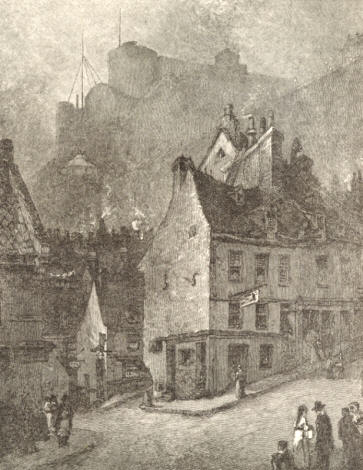
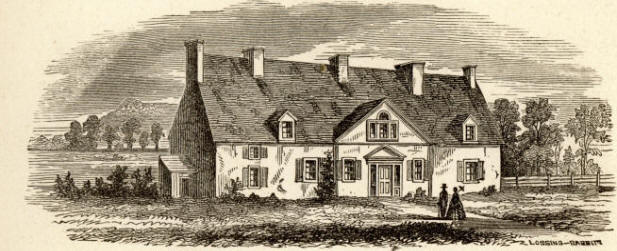
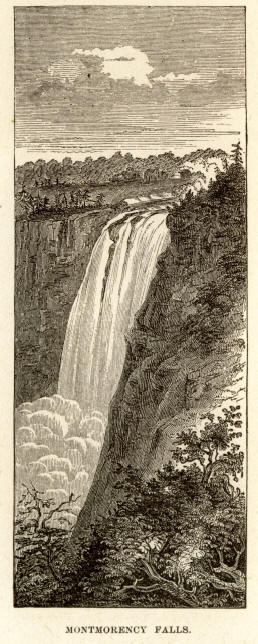 Two
months passed away; very little progress had been made towards
conquest; and no other intelligence had been received from Amherst
than a report by the enemy that he had retreated. The season for
action was rapidly passing. The prospect was discouraging; yet
Wolfe, though prostrated by sickness, was full of hope. He called a
council of officers at his bedside, and, on the suggestion of
General Townshend, it was resolved to scale the Heights of Abraham
from the St. Lawrence and assault the town. A plan was instantly
matured, and, feeble as Wolfe was from the effects of fever, he
resolved to Lead the assault in person. The camp below the
Montmorency was broken up (September 8), and the attention of
Montcalm was diverted from the real designs of the English by
seeming preparations to attack his lines. Even De Bougainville, whom
Montcalm had sent up the river with 1,500 men to guard against an
attack above the town, had no suspicions of their intentions, so
secretly and skillfully had the affair been managed. The troops had
been withdrawn from the Isle of Orleans and placed on shipboard, and
on the evening of September 12 the vessels moved up the stream
several miles above the intended landing-place, which was at a cove
at the foot of a narrow ravine, a short distance above the town,
that led up to the Plains of Abraham. At midnight the troops left
the ships, and in flat-bottomed boats, with muffled oars, went down
to the designated landing-place, where they disembarked. At dawn
(September 13) Lieutenant-Colonel Howe (afterwards General
Two
months passed away; very little progress had been made towards
conquest; and no other intelligence had been received from Amherst
than a report by the enemy that he had retreated. The season for
action was rapidly passing. The prospect was discouraging; yet
Wolfe, though prostrated by sickness, was full of hope. He called a
council of officers at his bedside, and, on the suggestion of
General Townshend, it was resolved to scale the Heights of Abraham
from the St. Lawrence and assault the town. A plan was instantly
matured, and, feeble as Wolfe was from the effects of fever, he
resolved to Lead the assault in person. The camp below the
Montmorency was broken up (September 8), and the attention of
Montcalm was diverted from the real designs of the English by
seeming preparations to attack his lines. Even De Bougainville, whom
Montcalm had sent up the river with 1,500 men to guard against an
attack above the town, had no suspicions of their intentions, so
secretly and skillfully had the affair been managed. The troops had
been withdrawn from the Isle of Orleans and placed on shipboard, and
on the evening of September 12 the vessels moved up the stream
several miles above the intended landing-place, which was at a cove
at the foot of a narrow ravine, a short distance above the town,
that led up to the Plains of Abraham. At midnight the troops left
the ships, and in flat-bottomed boats, with muffled oars, went down
to the designated landing-place, where they disembarked. At dawn
(September 13) Lieutenant-Colonel Howe (afterwards General
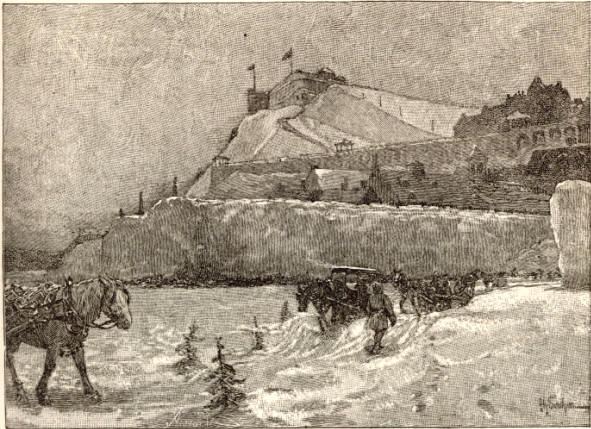
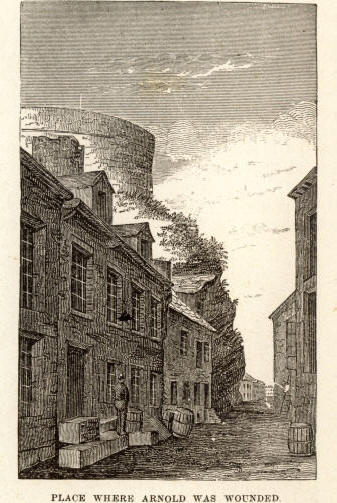 While
Colonel Arnold led 350 men to assault the city on the St. Charles
side, Colonel Livingston made a feigned attack on the St. Louis
Gate, and Major Brown menaced Cape Diamond Bastion. At the same time
Montgomery descended to the edge of the St. Lawrence with the
remainder of the army, and made his way along the narrow shore at
the foot of Cape Diamond. The plan was for the troops of Montgomery
and Arnold to meet and assail Prescott Gate on the St. Lawrence
side, and, carrying it by storm, enter the city. The whole plan had
been revealed to Carleton by a Canadian deserter, and the garrison
was prepared. A battery was placed at a narrow pass on the St.
Charles side, and a blockhouse with masked cannon occupied the
narrow way at the foot of Cape Diamond. Montgomery found that pass
blocked with ice, and blinding snow was falling fast. He pressed
forward, and after passing a deserted barrier approached the
blockhouse. All was silent there. Believing the garrison not to be
on the alert, Montgomery shouted to the companies of Captains Mott
and Cheeseman near him, "Men of
While
Colonel Arnold led 350 men to assault the city on the St. Charles
side, Colonel Livingston made a feigned attack on the St. Louis
Gate, and Major Brown menaced Cape Diamond Bastion. At the same time
Montgomery descended to the edge of the St. Lawrence with the
remainder of the army, and made his way along the narrow shore at
the foot of Cape Diamond. The plan was for the troops of Montgomery
and Arnold to meet and assail Prescott Gate on the St. Lawrence
side, and, carrying it by storm, enter the city. The whole plan had
been revealed to Carleton by a Canadian deserter, and the garrison
was prepared. A battery was placed at a narrow pass on the St.
Charles side, and a blockhouse with masked cannon occupied the
narrow way at the foot of Cape Diamond. Montgomery found that pass
blocked with ice, and blinding snow was falling fast. He pressed
forward, and after passing a deserted barrier approached the
blockhouse. All was silent there. Believing the garrison not to be
on the alert, Montgomery shouted to the companies of Captains Mott
and Cheeseman near him, "Men of